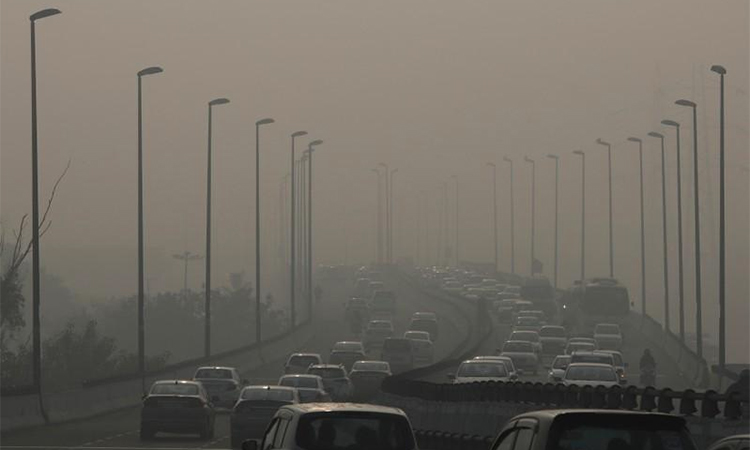
A heavily polluted, busy road in New Delhi’s capital city.
At an event, which has over 60 journalists participating from across India, Mr Bhupender Yadav, Indian Union minister of environment, forests and climate change, released Down To Earth’s Annual State of India’s Environment Report 2022.
Speaking at an annual conclave of journalists organised by Delhi-based Centre for Science and Environment (CSE) called the Anil Agarwal Dialogue last week, Mr Yadav said, “Reducing consumption and forming a self-restrained society is the only way that we can live with nature harmoniously.”
The SoE 2022 report, published every year by Down To Earth, is a comprehensive documentation of the year’s major developments and happenings in a wide range of subjects and issues — ranging from climate change, waste management, and the pandemic to air and water pollution, industrial contamination and food. The report has a comprehensive set of infographics and statistical analysis of how India’s states are faring in meeting the Sustainable Development Goals (SDGs).
Mr Yadav highlighted three extremely critical issues that confronts the nation today — climate change, desertification, and the sustainability-affordability linkage, according to a CSE press release. He said: “We can change people’s lives by linking affordability with sustainability. We must link traditional knowledge with scientific temperament. Sometimes we are so proud to have traditional knowledge that logic is lost. But we have to think of logic and affordability along with tradition to make it work.”
Answering questions addressed to him by the assembled journalists, he stressed on the fact that his ministry is keen to have an “open debate on environment”. He said: “Our goals are the same: how to ensure a good life for everybody. We should learn from each other.”
Referring to India’s efforts to achieve net zero by 2070, the minister pointed out that since emissions from the energy sector were the highest, the government was putting more emphasis on it. He said: “By 2030, we plan to have 500 GW from renewable energy. Railways will be electrified by 2030 — that will reduce 80 billion tonnes of emissions. We also plan to use LED bulbs on large scales, which can reduce 40 million tonnes of emissions. We are also focusing on hydrogen. If we can make hydrogen sustainable and affordable, we can bring big changes in the world.”
Talking of global climate negotiations and India’s position, he said that environmental negotiations “is not about give and take — it is about saving humanity. The developed nations must take historic responsibility and consider what their ancestors have done in the past.”
The report 2022 states that India is behind at least 17 key targets. These targets have a deadline of 2022. The slow progress made thus far makes it unlikely that these deadlines will be met.
CSE director general Sunita Narain said, “In the last two years, the world has seen disruption at a scale not seen before. Both COVID-19 and climate change are the result of our ‘dystopian’ relationship with nature — call this the revenge of nature…COVID-19 happened because humans had broken the barrier between wild habitats and the way humanity produced its food. Climate change was the result of emissions needed for economic growth.”
“Both are also linked and are being exacerbated because of our mismanagement of health systems and the environment…India needs to act in its own self-interest. Our climate change strategy has to be based on the principle of co-benefits — we will do something for climate change because it is good for the world, but also because it is good for us… We need a low-carbon strategy for every sector; we must also ask the developed world to pay for and give us the high-cost options so that we can leapfrog,” she added.
The Dialogue brought together journalists, environmental experts, and others from all parts of India, after almost two years of a pandemic-induced hiatus, as stated in the CSE press release. It focused on the twin challenges of climate change and pandemic. It had sessions on viruses in our environment; the COVID-19 pandemic and what lessons it offers us for the future; climate change and extreme weather events; how should India chart its energy roadmap to meet its climate commitments; the latest IPCC report on adaptation; climate change and urbanisation; electric mobility; the state of India’s forests; the agriculture-biodiversity-livelihood-nutrition connections; biodiversity and the Great Extinction; amendments to the Biodiversity Act; and the human impacts of climate change (as witnessed in the large-scale migration across the world).


